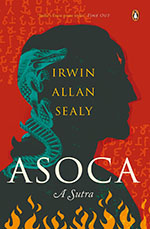In Asoca: A Sutra, Irwin Allan Sealy attempts to present the ‘real man’ behind Emperor Ashoka the Great. He uses the spelling ‘Asoca’ to suggest a soft ‘k’, highlighting the way simple villagers pronounce the name, for his mother was not of royal birth. The ‘s’ is pronounced as a sibilant (‘assoka’) in place of the palatal ‘s’ of Sanskrit. Sealy employs the Pali forms for all the names, corresponding to actual usage, rather than written records—Susima, Mahinda, Sanghamitta rather than Sushumna, Mahendra and Sanghamitra. Ashoka used Pali, the language of the common people, for his rock edicts in the Indo-Gangetic plain, giving importance to regional dialects and scripts in his empire’s outlying areas like Afghanistan. Very little was known about him till the nineteenth century Indologists translated his rock and pillar edicts. Sealy observes in his Preface, ‘Unconcerned with scholarship, I have browsed in commons and enclosures, among popular histories and academic texts, even a wartime Dutchman’s immense and tiresome saga of the king.’ Though he claims to be ‘unconcerned with scholarship’, his portrait of Ashoka the Great takes cognizance of extant scholarship in Mauryan history, including literature about Kautilya and his Arthashastra. Emotional inputs from various stages of his life are equally important—‘The great rock edict at Kalsi,… From early childhood shines a visit to the ruins at Sarnath, site of the Buddha’s first sermon, while the hill of the stupa at Sanchi hallowed a tranquil moment in middle life.
October 2022, volume 46, No 10

